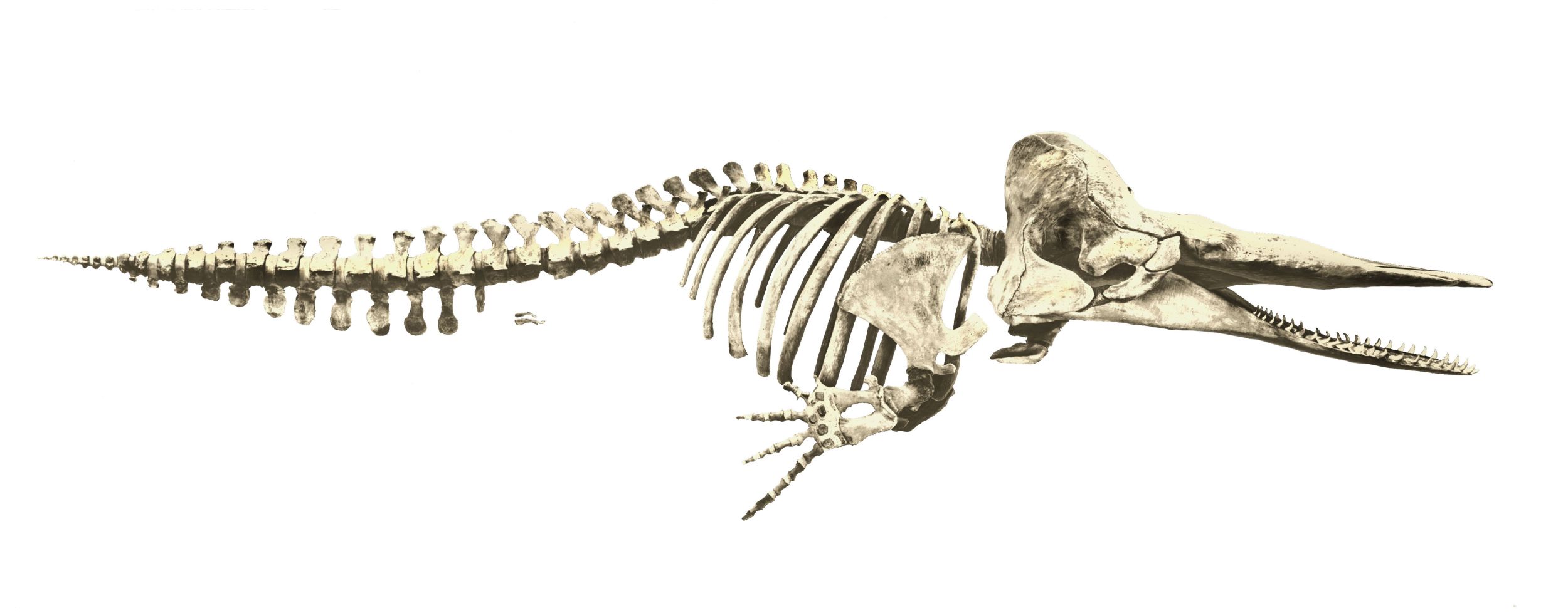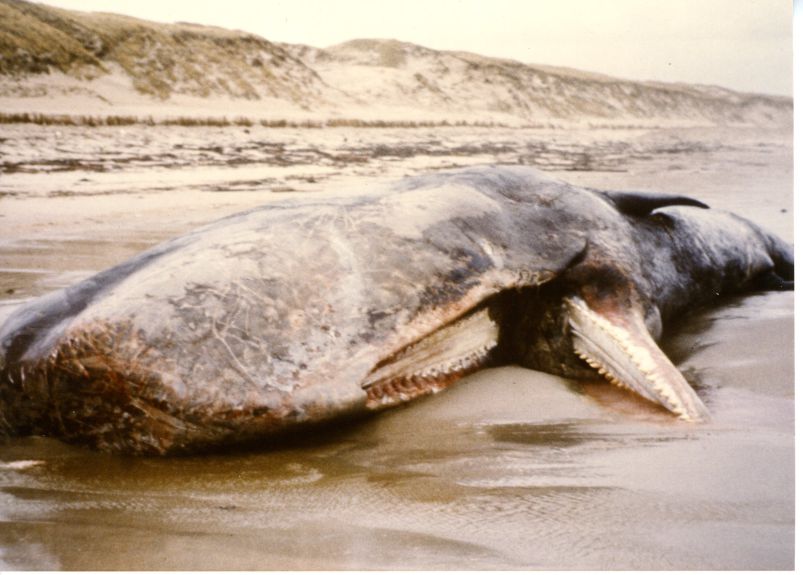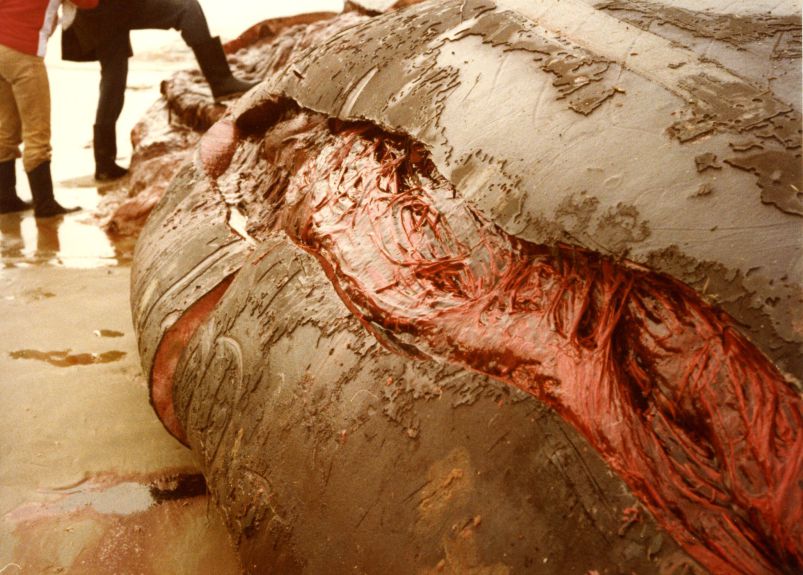Next to the Museon-Omniversum entrance this enormous skeleton of a sperm whale can be seen. The animal was washed ashore on the beach of Egmond aan Zee on 15 December 1979.
Personal details of the sperm whale in the Museon
Found dead on beach at Egmond aan Zee on 15 December 1979• Estimated age: 10 - 13 years
• Total length: 15 metres
• Length of skull: 4.75 metres
• Total weight: 30,000 kg
• Weight of skull: 1,400 kg
• Weight of whole skeleton: 2,500 kg
• Sex: male
• Cause of death: unknown
• Acquisition no: 100,000
General particulars
Habitat: all of the oceans and occasionally the North Sea• Lives in groups of up to 40+ whales
• Fertile every 3 to 5 years
• Gestation time: 14 to 15 months
• Size at birth: 4 metres
• Maximum life span: 70 years
• Food: more than 1,000 kg a day
• Diving speed: 7 km/hr
• Brain weight: 8 kg (human: 1.3 kg)
What can you do with a sperm whale?
My, you smell nice!
Ambergris is used as a fragrance in the production of perfumes. It’s such a rare substance that it makes them very expensive. Ambergris is pooped out by sperm whales and when it’s found it’s usually grey and solid like wax. Lumps of it weighing up to 45 kg float around at sea and sometimes get washed up on beaches.
A number of artificial fragrances have been developed to imitate ambergris. They include Grisalva, Ambreine and Ambroxan. One of them is used, for example, in Christian Dior’s “Dune”. .Sperm whale candle
The head of every sperm whale contains an organ filled with a white, waxy substance. People used to believe (wrongly) that this was the whale’s sperm. That’s why it’s known it’s known as spermaceti.
Spermaceti oil used to be a valuable product. It was used to make candles, soap, cosmetics and machine oil. An adult male sperm whale can have up to 3,000 kg of spermaceti in its head, so from just one whale you could make an awful lot of candles!<>
<>Whale meat sandwich
In Japan whale meat is eaten in very thin slices or as steaks. Whale meat sandwiches are popular too. Sounds delicious, doesn’t it?
As a result of large-scale commercial hunting using explosive grenade harpoons, there are very few whales left these days. Some species have actually been completely wiped out.
Protection? Quickly, please!
To stop whales going extinct, a worldwide ban on commercial whaling was introduced in 1986. Now, the only kinds of whaling allowed are traditional whale hunts and catches for scientific purposes. But Norway and Iceland ignore the ban and Japan uses scientific research as a cover for commercial whaling.
Diving, how do they do it??
Sperm whales can dive incredibly deep and hold their breath for an amazingly long time. They can only do this because it takes so little energy. Before diving, the whale changes ninety per cent of the air in its lungs by taking several deep breaths. A lot of the oxygen is stored in its muscles, not in its lungs. Also, parts of its blood circulation system shut down, so that the bits of the whale’s body that don’t need much oxygen are sealed off.
The head of an adult male sperm whale contains at least 3,000 kg of spermaceti. Water let in through its single nostril (blowhole) cools down the spermaceti and makes it solidify. This makes the whale much heavier, so that it sinks.
After the whale has fed deep underwater, warm blood flows from the rear of its body to its head and heats up the spermaceti, making it turn liquid and expand. As a result, the whale gets lighter again and floats up to the surface without much effort.
Op het strand van Egmond
Algemeen Potvis-paspoort
Leefgebied: alle wereldzeeën, zelden in de Noordzee
• Leefwijze: kuddes tot meer dan 40 exemplaren
• Elke 3 tot 5 jaar vruchtbaar
• Draagtijd: 14 tot 15 maanden
• Geboortelengte: 4 meter
• Maximale leeftijd: 70 jaar
• Voedsel: meer dan 1.000 kilo per dag
• Duiksnelheid: 7 km/uur
• Hersenen: 8 Kilo (mens: 1,3 kilo)
Duiken, hoe doet ie het?
Zo diep en zo lang duiken zonder tussendoor te hoeven ademen kan alleen als het energieverbruik extreem laag is. Voor een duik ververst de potvis negentig procent van zijn longinhoud door een aantal maal diep in en uit te ademen. Een groot deel van de zuurstof wordt niet in de longen maar in de spieren opgeslagen. Ook wordt een deel van de bloedsomloop afgesloten, waardoor lichaamsdelen die weinig zuurstofbehoefte hebben worden stilgelegd. In de kop van een mannetjes potvis zit minstens 3.000 kg spermaceti. Door water in te laten in het enige neusgat koelt de spermaceti af en stolt. De potvis wordt hierdoor veel zwaarder en gaat vanzelf zinken.
Na beneden te hebben gegeten, stroomt warm bloed uit het achterdeel van het lichaam naar de kop en warmt de spermaceti op. De spermaceti wordt weer vloeibaar en zet uit. De potvis wordt weer lichter en stijgt zonder veel inspanning naar de oppervlakte.
Wat kun je zoal met een potvis doen?
Wat ruik je lekker!
Amber (collectie) wordt gebruikt als geurstof bij de productie van parfum. Omdat amber zeldzaam is, is deze parfum enorm duur. Potvissen poepen het meestal grijze en harde wasachtige spul uit. Het drijft in klompen tot 45 kilo op zee en spoelt soms aan op stranden.
Om de geur van amber na te bootsen zijn er verschillende kunstmatige geurstoffen ontwikkeld, zoals Grisalva, Ambreine en Ambroxan. Zo’n imitatiepotvisgeurtje zit bijvoorbeeld in Christian Dior’s Dune.
Potviskaars
In de kop van de potvis zit een orgaan dat gevuld is met een witte, wasachtige stof. Vroeger dacht men ten onrechte dat de potvisstier zijn sperma in zijn kop bewaarde. Vandaar de naam: spermaceti-orgaan.
Spermaceti-olie was vroeger een waardevol product. Er werden kaarsen, zeep, cosmetica en machineolie van gemaakt. Een volwassen mannetjes potvis kan wel 3.000 kilo spermaceti-olie in zijn kop hebben. Van één potvis kun je heel wat kaarsen maken!
Broodje walvis
In Japan wordt walvisvlees in de vorm van carpaccio en biefstuk gegeten. Op een broodje kan ook. Klinkt best lekker, toch? Door grootschalige jacht met harpoenen voorzien van een granaat werden walvissen schaars. Sommige soorten raakten zelfs “op”.
Bescherming? Opschieten aljeblieft!
Om uitsterven te voorkomen is de jacht op walvissen in 1986 wereldwijd verboden. Alleen traditionele vangst en de vangst voor wetenschappelijke doeleinden zijn toegestaan. Noorwegen en IJsland negeren het verbod en Japan gebruikt wetenschappelijk onderzoek om met de commerciële walvisjacht door te gaan.



